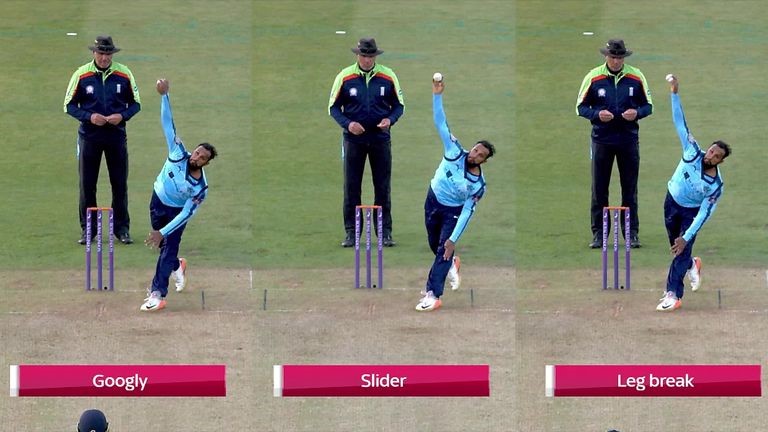Leg break bowling is one of the hardest cricket skills to master. Getting the ball to spin is one of the most challenging parts of it, but many bowlers also struggle with their accuracy and speeds when bowling these deliveries! A bowler who can master these three aspects of leg break bowling should be well on their way to success in the game of cricket.
So, what does the perfect leg break look like? Many people think that the ball Shane Warne bowled to Mike Gatting in 1993 (now referred to as ‘The Gatting Ball’) is an example of the perfect leg break. You can learn to bowl the perfect leg break delivery by focusing on the following areas:
- The Grip
- The Run-Up / Approach
- How the Spin Is Applied to The Leg Break?
- Where to Pitch the Leg Break
- The Speed of The Bowling
What Grip Is Used When Bowling the Leg Break?
The grip needed for the leg break is commonly referred to as the ‘Two up, two down’ grip. This means that two fingers of your bowling hand (index and middle fingers) will be on top of the ball with the seam running across them, whilst the ring finger and little finger will sit alongside the ball for support.

What Does A Typical Run Up Look Like for Leg Break Bowlers?
The approach to the crease for a leg break bowler is much shorter than it is for a fast bowler. The purpose of a spin bowling run up is to build up a small amount of momentum, so that when we reach the popping crease, some of this momentum can be used to propel the ball towards the batsman!
All spin bowlers will have a different approach to the crease, no two are the same! It is for this reason that I can’t give you an exact process to follow…but what I can do is highlight some common themes that exist within the run ups of many different professional leg break bowlers! Hopefully these will give you a good starting point!
Most leg break bowlers will have a run up to the crease which is around approximately 5 – 10 paces in length.
- Often, the approach to the crease will start at walking pace.
- The last 40% of the approach to the wicket involves the bowler increasing the pace of their steps. These faster steps almost look like skipping and allow us to build momentum towards the target.
- Try to minimise sideways movement during your approach to the crease. If your run up involves lots of side to side movement, then some of your forwards momentum will be wasted. If you are someone who likes to play with the ball and spin it between your hands as you run in to bowl, try not to make this movement too extravagant. Your focus during the run up should be on what you are trying to achieve with the next delivery.
The Gather: Both hands should be in front of the body and the weight should be moving forward. There is no rock back as in seam or swing bowling.

Back-Foot Landing: The back foot must land parallel to the bowling crease. The hips and shoulders are aligned towards the target.
Delivery Stride: As a rule, the delivery stride should be a little more than shoulder width. The head should lead the shoulders, hips and non-bowling arm directly towards the target.
Front-Foot Landing: The front foot should land firmly on the ball of the foot with the weight well forward and the leg braced. The back and front heels should be aligned, and the front toe should be pointing toward fine leg, to help form a stable base. The front arm should be pushing out hard towards the target.

The Release: The weight should be over a braced front leg with the release position of the bowling hand at approximately 30 degrees to the vertical. The bowling wrist should un-cock (unlock) with the palm of the hand facing the batsman.

Follow-Through: If all the other aspects of the action are correct, the shoulders and hips will drive powerfully through with both arms coming across the body to complete a 180-degree rotation.

How Is Spin Applied to The Leg Break?
Now for the most crucial bit! How do we actually get the ball to spin when it hits the pitch? Luckily, the answer is quite simple. But it still requires a lot of practice to get right! Let’s look at the process below:
- The bowler stands at the top of their run up mark and begins their run up/bowling action as usual.
- As the bowler is about to arrive at the crease, the ‘coil’ phase of the action begins. This is the part where the bowling arm is brought up towards your head, before it begins its final rotation where the ball will be delivered.
- During the coil phase the wrist of the bowling arm should be ‘cocked’, or tilted towards your head. The wrist should be kept in this position from this point until the moment we are about to release the ball.
- After the coil phase, the bowling arm rotates all the way around. The ball is released as the arm gets to its highest point.
- The spin is now applied as the ball exits the bowlers hand. The wrist is rotated quickly in an inward direction, and this allows the index and the middle finger to begin the process of applying leg spin to the ball. The ring finger is where the real action happens! In the leg break grip, the ring finger is originally located towards the bottom of the ball, as a means of providing support. But now, once the process of spinning the ball has been started due to the rotation of the wrist, the ring finger moves up and across the top surface of the ball as it is released from the hand. This causes the ball to spin in the desired direction!


- The desired direction of spin for a leg break is at roughly a 45-degree angle to the batsman. I have used a diagram below to illustrate this. If you spin the ball too far forwards, directly towards the batsman, then you will get top spin on the ball, primarily resulting in extra bounce. If you put too many sideways rotations on the ball, at a 90-degree angle to the batsman, then there is a chance the ball could fail to spin altogether and slide towards the batsman
Where to Pitch The Leg Break

Some of you may be asking where we should mainly be looking to land the leg break! The answer to this depends on several factors, here are 5 for you to consider:
- The Batting Style – This one may be obvious, but we should be looking to pitch the ball in different areas depending on whether the batsman is right or left-handed!
- The Shot We Want The Batsman To Play – Shane Warne has often said that instead of looking at where he wanted the ball to pitch as he approached the crease (like a lot of spinners do), he would instead be thinking about what shot he wanted to get the batsman to play!
- Weaknesses of The Batsman – Professional bowlers always study opposing batsmen intently before they play them, to uncover any weaknesses they may have. You can do the same thing during a game!
- The Field Placings – The field that your captain has set for you may influence the areas where you look to bowl. If a captain has set a defensive leg side field, then you know that you can bowl more of your deliveries targeting the batsman’s pads. This is because you have that added security on the leg-side should the batsman choose to aggressively attack the ball in that area. Similarly, a strong off-side field should encourage you to bowl more of your deliveries outside the off stump of the batsman, knowing that if they do play a good shot and hit you in that area, you have the fielders in place to limit the runs! If you’re bowling to very attacking field placings with a lot of fielders around the bat, it is important to get the ball in those dangerous areas that I’ve previously talked about. Look to either get the batsman driving or attack the stumps. Any inside or outside edge due to a slight misjudgement has a chance of being caught by one of the close in fielders!
- Conditions of The Pitch – Certain pitches are harder than others, allowing us to extract more bounce from the surface. Certain pitches are drier than others, allowing us to spin the ball easier and further. Whilst bowling you should always be looking at how much bounce you are getting on the ball and adjust your lengths accordingly. If you can take one piece of information away from this section, make sure it’s the fact that the perfect leg break delivery is one that will draw the batsman into driving the ball! This shot is a good scoring option for batsmen to use against us, but it also opens up many more wicket taking opportunities on our behalf!
What Speed Should the Leg Break Be Bowled At?
A lot of leg break bowlers have questions about what sort of speeds they should be trying to bowl at. At the professional level, most leg break bowlers will bowl at a speed somewhere in the range of 70-95kph (45-60mph). Obviously if you are a younger bowler there is a good chance that you may bowl slower than this.
If I was just starting to bowl leg spin, I wouldn’t worry too much about the pace that you are bowling! Just focus on getting the ball to spin consistently, and work on your accuracy. Once you have these things more finely tuned, you can begin experimenting with the pace of your leg break. As a rule though, you should guard against trying to bowl the ball too fast. Some spinners have this tendency, especially when they don’t want to get hit for boundaries! Many of them think the solution is to fire the deliveries in a lot quicker, but trust me, this really isn’t necessary! Doing this can also take our focus away from trying to spin the ball, which should be our primary aim! Sometimes, spin is a lot more effective when you bowl the ball a tad slower and ‘toss the ball up’. Tossing the ball up is often also referred to as ‘getting the ball above the batsman’s eyeline’, and it basically refers to how high the ball we get the ball during its flight. Getting the ball above the eyeline of the batsman can cause them to misjudge the length of the ball. This is just another method that leg break bowlers can use to dismiss a batsman.
Other Commonly Asked Questions
How Do You Get A Leg Break To Drift?
The term ‘drift’ describes the way some spin bowlers can get the ball to move laterally in the air before it pitches. This means that if a ball is originally bowled on an off-stump line, it could potentially drift in towards the leg stump before pitching and spinning away. The ball can drift in either direction, and there are a few factors I’d like to briefly explain that can help us get the ball to behave in this way!
- The Number of Revolutions on The Ball – To put it simply, the more aggressively you spin the ball, the more chance you have of getting the ball to drift. Applying side spin to the ball can cause the ball to drift left or right, whereas applying top spin can cause the ball to dip rapidly.
- Get Plenty of Flight on The Ball – Tossing the ball up a bit higher when you bowl increases the chance that the air will have an effect on the ball. It’s very simple to explain why this happens. It’s literally due to the fact that the ball will be spending longer in flight, giving the air more chance to act upon it. Deliveries that are fired towards the batsman on a flatter trajectory spend less time in the air, and therefore they’re much less likely to drift.
- A Strong Breeze – This one may be obvious but bowling into a breeze can obviously increase the chance that a ball will drift in the air. This is especially true when you toss the ball up and increase its time in flight!
A combination of these three factors should allow you to drift the ball. Drift can be deadly and allows us to confuse the batsman and force them into mistakes before the ball has even pitched! Again, if you take any one thing away from this section make sure it is the fact that drift largely comes down to the number of revolutions you can get on the ball. If you teach yourself to spin the ball a lot, you can get all sorts of associated benefits such as this!
Finally,…
I hope this post has inspired some quality leg break bowlers of the future! This post contained all of the tips and info that you will need to bowl a good leg break! However, most of you are probably aware that spinners don’t just bowl one type of delivery! Many of them have multiple different ‘variation’ deliveries that they can use to trick batsmen. Some of these will bounce more, some will be bowled quicker, and some will spin in different directions!




